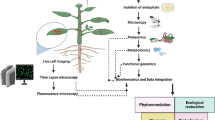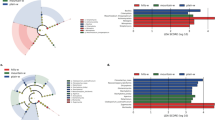Abstract
This study aimed to investigate whether the presence of trichomes as conspicuous physical attributes of the leaf surface affects the microbial community composition on Arabidopsis thaliana leaves. The A. thaliana ecotype Col-0 and its trichomeless gl1 mutant were grown in growth cabinets under climate-controlled conditions. The gl1 mutant showed a similar wax composition as the Col-0 wild type with slightly reduced amounts of C29, C31 and C33 alkanes by GC/MS and GC/FID analyses. 120 bacterial isolates representing 39 bacterial genera were obtained from A. thaliana Col-0 leaf surfaces. Phylogenetic analysis of nearly full-length 16S rRNA sequences from 29 selected isolates confirmed their affiliation to the Proteobacteria (Alpha-, Beta-, Gamma-), Actinobacteria, Bacteroidetes and Firmicutes. The bacterial diversity on A. thaliana ecotype Col-0 and its gl1 mutant, devoid of trichomes, were further compared by denaturing gradient gel electrophoresis (DGGE). Banding patterns and sequencing of representative DGGE bands revealed the presence of phylotypes related to Sphingomonas (Alphaproteobacteria), Methylophilus (Betaproteobacteria) and Dyadobacter (Bacteroidetes) which are common phyllosphere inhabitants. Furthermore, wildtype and trichomeless mutant plants were exposed to outdoor conditions for 4–5 weeks. The DGGE gels showed only minor differences between the two plant lines, thus suggesting that trichomes per se do not affect bacterial diversity on Arabidopsis leaves under the experimental conditions tested.




Similar content being viewed by others
References
Ashelford KE, Chuzhanova NA, Fry JC, Jones AJ, Weightman AJ (2005) At least 1 in 20 16S rRNA sequence records currently held in public repositories estimated to contain substantial anomalies. Appl Environ Micorbiol 71:7724–7736
Baldotto LEB, Olivares FL (2008) Phylloepiphytic interaction between bacteria and different plant species in a tropical agricultural system. Can J Microbiol 54:918–931
Balint-Kurti P, Simmons SJ, Blum JE, Ballaré CL, Stapleton AE (2010) Maize leaf epiphytic bacteria diversity patterns are genetically correlated with resistance to fungal pathogen infection. Mol Plant-Microbe Interact 23:473–484
Barak JD, Kramer LC, Hao L-Y (2011) Plant cultivar alters Salmonella enterica colonization of tomato and Type I trichomes are preferential colonization sites. Appl Environ Microbiol 77:498–504
Beattie GA, Lindow SE (1995) The secret life of foliar bacterial pathogens on leaves. Annu Rev Phytopathol 33:145–172
Beattie GA, Lindow SE (1999) Bacterial colonization of leaves: a spectrum of strategies. Phytopathology 89:353–359
Broun P, Poindexter P, Osborne E, Jiang C-Z, Riechmann JL (2004) WIN1, a transcriptional activator of epidermal wax accumulation in Arabidopsis. Proc Natl Acad Sci USA 101:4706–4711
Chelius MK, Triplett EW (2001) The diversity of archaea and bacteria in association with the roots of Zea mays L. Microb Ecol 41:252–263
Delmotte N, Knief C, Chaffron S, Innerebner G, Roschitzki B, Schlapbach R, von Mering C, Vorholt JA (2009) Community proteogenomics reveals insights into the physiology of phyllosphere bacteria. Proc Natl Acad Sci USA 106:16428–16433
Forney LJ, Zhou X, Brown CJ (2004) Molecular microbial ecology: land of the one-eyed king. Curr Opin Microbiol 7:210–220
Galbally IE, Kristine W (2002) The production of methanol by flowering plants and the global cycle of methanol. J Atmos Chem 43:195–229
Giese BN (1975) Effects of light and temperature on the composition of epicuticular wax of barley leaves. Phytochemistry 14:921–929
Hunter PJ, Hand P, Pink D, Whipps JM, Bending GD (2010) Both leaf properties and microbe–microbe interactions influence within-species variation in bacterial population diversity and structure in the lettuce (Lactuca species) phyllosphere. Appl Environ Microbiol 76:8117–8125
Jacobs JL, Sundin GW (2001) Effect of solar UV-B radiation on a phyllosphere bacterial community. Appl Environ Microbiol 67:5488–5496
Jetter R, Schäffer S (2001) Chemical composition of the Prunus laurocerasus leaf surface. Dynamic changes of the epicuticular wax film during leaf development. Plant Physiol 126:1725–1737
Johnson HB (1975) Plant pubescence: an ecological perspective. Bot Rev 41:233–253
Kinkel LL, Wilson M, Lindow SE (2000) Plant species and plant incubation conditions influence variability in epiphytic bacterial population size. Microb Ecol 39:1–11
Knief C, Frances L, Vorholt JA (2010a) Competitiveness of diverse Methylobacterium strains in the phyllosphere of Arabidopsis thaliana and identification of representative models, including M. extorquens PA1. Microb Ecol 60:440–452
Knief C, Ramette A, Frances L, Alonso-Blanco C, Vorholt JA (2010b) Site and plant species are important determinants of the Methylobacterium community composition in the plant phyllosphere. ISME J 4:719–729
Kniskern JM, Traw MB, Bergelson J (2007) Salicylic acid and jasmonic acid signalling defense pathways reduce natural bacterial diversity on Arabidopsis thaliana. Mol Plant-Microbe Interact 20:1512–1522
Kosma DK, Bourdenx B, Bernard A, Parsons EP, Lü S, Joubès J, Jenks MA (2009) The impact of water deficiency on leaf cuticle lipids of Arabidopsis. Plant Physiol 151:1918–1929
Lane DJ (1991) 16S/23S rRNA sequencing. In: Stackebrandt E, Goodfellow M (eds) Nucleic acid techniques in bacterial systematics. Wiley, London, pp 115–175
Leveau JHJ (2006) Microbial communities in the phyllosphere. In: Riederer M, Müller C (eds) Biology of the plant cuticle. Blackwell Publishing, Oxford, pp 333–366
Leveau JHJ, Lindow SE (2001) Appetite of an epiphyte: quantitative monitoring of bacterial sugar consumption in the phyllosphere. Proc Natl Acad Sci USA 98:3446–3453
Lindow SE, Brandl MT (2003) Microbiology of the phyllosphere. Appl Environ Microbiol 69:1875–1883
Ludwig W, Strunk O, Westram R et al (2004) ARB: a software environment for sequence data. Nucleic Acids Res 32:1363–1371
Marcell LM, Beattie G (2002) Effect of leaf surface waxes on leaf colonisation by Pantoea agglomerans and Clavibacter michiganensis. Mol Plant-Microbe Interact 15:1236–1244
Monier JM, Lindow SE (2004) Frequency, size, and localization of bacterial aggregates on bean leaf surfaces. Appl Environ Microbiol 70:346–355
Morris CE, Monier JM, Jacques MA (1997) Methods for observing microbial biofilms directly on leaf surfaces and recovering them for isolation of culturable microorganism. Appl Environ Microbiol 63:1570–1576
Muyzer G, Brinkhoff T, Nübel U, Santegoeds C, Schäfer H, Wawer C (1998) Denaturing gradient gel electrophoresis (DGGE) in microbial ecology. In: Akkermans ADL, van Elsas JD, de Bruijn FJ (eds) Molecular microbial ecology, manual 3.4.4. Kluwer, Dordrecht, pp 1–27
O’Brien RD, Lindow SE (1989) Effect of plant species and environmental conditions on epiphytic population sizes of Pseudomonas syringae and other bacteria. Phytopathology 79:619–627
Oppenheimer DG, Herman PL, Esch J, Sivakumaran S, Marks MD (1991) A myb-related gene required for leaf trichome differentiation in Arabidopsis is expressed in stipules. Cell 67:483–493
Plotnikova JM, Rahme LG, Ausubel FM (2000) Pathogenesis of the human opportunistic pathogen Pseudomonas aeruginosa PA14 in Arabidopsis. Plant Physiol 124:1766–1774
Pruesse E, Quast C, Knittel K, Fuchs BM, Ludwig W, Peplies J, Glöckner FO (2007) SILVA: a comprehensive online resource for quality checked and aligned ribosomal RNA sequence data compatible with ARB. Nucleic Acids Res 35:7188–7196
Rastogi G, Tech JJ, Coaker GL, Leveau JHJ (2010) A PCR-based toolbox for the culture-independent quantification of total bacterial abundances in plant environments. J Microbiol Methods 83:127–132
Redford AJ, Bowers RM, Knight R, Linhart Y, Fierer N (2010) The ecology of the phyllosphere: geographic and phylogenetic variability in the distribution of bacteria on tree leaves. Environ Microbiol 12:2885–2893
Schlegel TK, Schönherr J, Schreiber L (2005) Size selectivity of aqueous pores in stomatous cuticles of Vicia faba leaves. Planta 221:648–665
Schmitt S, Angermeier H, Schiller R, Lindquist N, Hentschel U (2008) Molecular microbial diversity survey of sponge reproductive stages and mechanistic insights into vertical transmission of microbial symbionts. Appl Environ Microbiol 74:7694–7708
Sieber P, Schorderet M, Ryser U, Buchala A, Kolattukudy P, Métraux J-P, Nawrath C (2000) Transgenic Arabidopsis plants expressing fungal cutinase show alterations in structure and properties of the cuticle and postgenital organ fusions. Plant Cell 12:721–738
Yadav RKP, Karamanoli K, Vokou D (2005) Bacterial colonization of the phyllosphere of Mediterranean perennial species as influenced by leaf structural and chemical features. Microb Ecol 50:185–196
Zabka V, Stangl M, Bringmann G, Vogg G, Riederer M, Hildebrandt U (2008) Host surface properties affect prepenetration processes in the barley powdery mildew fungus. New Phytol 177:251–263
Acknowledgments
A. thaliana Col-0 and gl1 seeds were kindly provided by S. Berger, University of Würzburg. The authors thank J. Kamke, University of Würzburg, for assistance in phylogenetic tree construction. This project was financially supported by the DFG Graduiertenkolleg 1342 (TP A8/B8) to U. Hentschel/M. Riederer and Sonderforschungsbereich 567 (TP A5) to U. Hildebrandt/M. Riederer.
Author information
Authors and Affiliations
Corresponding author
Electronic supplementary material
Below is the link to the electronic supplementary material.
10482_2011_9669_MOESM1_ESM.eps
Supplementary Fig. 1: DGGE profiles of the phyllosphere microbiota of plants grown in growth chambers (see also Fig. 3), and the corresponding soil samples as well as plants grown under entirely sterile conditions in agar boxes. (EPS 1399 kb)
10482_2011_9669_MOESM2_ESM.eps
Supplementary Fig. 2: DGGE analysis of the phyllosphere microbiota of the A. thaliana wildtype and the trichomeless mutant (gl 1) that were grown outdoors 4–5 weeks. One PCR reaction per individual plant is shown. (EPS 611 kb)
10482_2011_9669_MOESM3_ESM.eps
Supplementary Fig. 3: Average Linkage (WPGAMA) analysis of DGGE gels shown in Fig. 3(A) and Supplementary Fig. 2(B). Scale bar represents percentage similarity by Dice coefficient. (EPS 861 kb)
10482_2011_9669_MOESM4_ESM.eps
Supplementary Fig. 4: Classification of 120 bacterial isolates obtained from A. thaliana Col-0 leaves based on partial 16S rRNA gene sequencing and BLAST analysis. (EPS 909 kb)
Rights and permissions
About this article
Cite this article
Reisberg, E.E., Hildebrandt, U., Riederer, M. et al. Phyllosphere bacterial communities of trichome-bearing and trichomeless Arabidopsis thaliana leaves. Antonie van Leeuwenhoek 101, 551–560 (2012). https://doi.org/10.1007/s10482-011-9669-8
Received:
Accepted:
Published:
Issue Date:
DOI: https://doi.org/10.1007/s10482-011-9669-8




